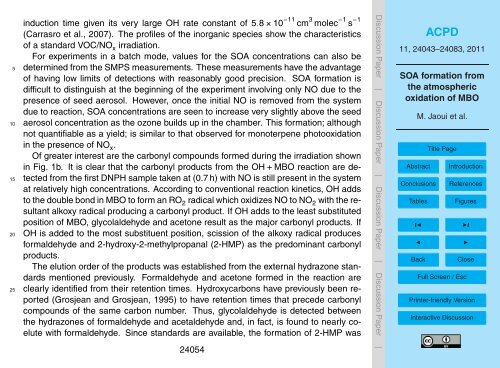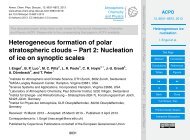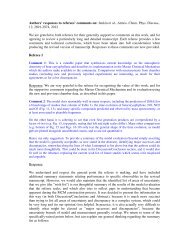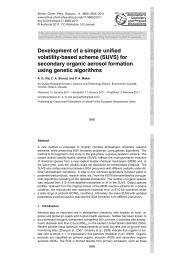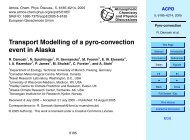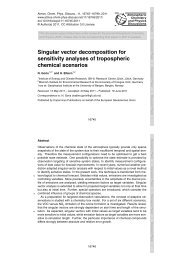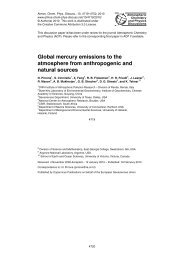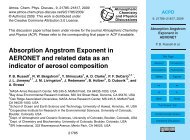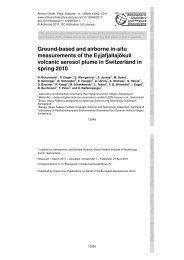SOA formation from the atmospheric oxidation of MBO - ACPD
SOA formation from the atmospheric oxidation of MBO - ACPD
SOA formation from the atmospheric oxidation of MBO - ACPD
Create successful ePaper yourself
Turn your PDF publications into a flip-book with our unique Google optimized e-Paper software.
5<br />
10<br />
15<br />
20<br />
25<br />
induction time given its very large OH rate constant <strong>of</strong> 5.8 × 10 −11 cm 3 molec −1 s −1<br />
(Carrasro et al., 2007). The pr<strong>of</strong>iles <strong>of</strong> <strong>the</strong> inorganic species show <strong>the</strong> characteristics<br />
<strong>of</strong> a standard VOC/NO x irradiation.<br />
For experiments in a batch mode, values for <strong>the</strong> <strong>SOA</strong> concentrations can also be<br />
determined <strong>from</strong> <strong>the</strong> SMPS measurements. These measurements have <strong>the</strong> advantage<br />
<strong>of</strong> having low limits <strong>of</strong> detections with reasonably good precision. <strong>SOA</strong> <strong>formation</strong> is<br />
difficult to distinguish at <strong>the</strong> beginning <strong>of</strong> <strong>the</strong> experiment involving only NO due to <strong>the</strong><br />
presence <strong>of</strong> seed aerosol. However, once <strong>the</strong> initial NO is removed <strong>from</strong> <strong>the</strong> system<br />
due to reaction, <strong>SOA</strong> concentrations are seen to increase very slightly above <strong>the</strong> seed<br />
aerosol concentration as <strong>the</strong> ozone builds up in <strong>the</strong> chamber. This <strong>formation</strong>; although<br />
not quantifiable as a yield; is similar to that observed for monoterpene photo<strong>oxidation</strong><br />
in <strong>the</strong> presence <strong>of</strong> NO x.<br />
Of greater interest are <strong>the</strong> carbonyl compounds formed during <strong>the</strong> irradiation shown<br />
in Fig. 1b. It is clear that <strong>the</strong> carbonyl products <strong>from</strong> <strong>the</strong> OH + <strong>MBO</strong> reaction are de-<br />
tected <strong>from</strong> <strong>the</strong> first DNPH sample taken at (0.7 h) with NO is still present in <strong>the</strong> system<br />
at relatively high concentrations. According to conventional reaction kinetics, OH adds<br />
to <strong>the</strong> double bond in <strong>MBO</strong> to form an RO 2 radical which oxidizes NO to NO 2 with <strong>the</strong> resultant<br />
alkoxy radical producing a carbonyl product. If OH adds to <strong>the</strong> least substituted<br />
position <strong>of</strong> <strong>MBO</strong>, glycolaldehyde and acetone result as <strong>the</strong> major carbonyl products. If<br />
OH is added to <strong>the</strong> most substituent position, scission <strong>of</strong> <strong>the</strong> alkoxy radical produces<br />
formaldehyde and 2-hydroxy-2-methylpropanal (2-HMP) as <strong>the</strong> predominant carbonyl<br />
products.<br />
The elution order <strong>of</strong> <strong>the</strong> products was established <strong>from</strong> <strong>the</strong> external hydrazone standards<br />
mentioned previously. Formaldehyde and acetone formed in <strong>the</strong> reaction are<br />
clearly identified <strong>from</strong> <strong>the</strong>ir retention times. Hydroxycarbons have previously been re-<br />
ported (Grosjean and Grosjean, 1995) to have retention times that precede carbonyl<br />
compounds <strong>of</strong> <strong>the</strong> same carbon number. Thus, glycolaldehyde is detected between<br />
<strong>the</strong> hydrazones <strong>of</strong> formaldehyde and acetaldehyde and, in fact, is found to nearly coelute<br />
with formaldehyde. Since standards are available, <strong>the</strong> <strong>formation</strong> <strong>of</strong> 2-HMP was<br />
24054<br />
Discussion Paper | Discussion Paper | Discussion Paper | Discussion Paper |<br />
<strong>ACPD</strong><br />
11, 24043–24083, 2011<br />
<strong>SOA</strong> <strong>formation</strong> <strong>from</strong><br />
<strong>the</strong> <strong>atmospheric</strong><br />
<strong>oxidation</strong> <strong>of</strong> <strong>MBO</strong><br />
M. Jaoui et al.<br />
Title Page<br />
Abstract Introduction<br />
Conclusions References<br />
Tables Figures<br />
◭ ◮<br />
◭ ◮<br />
Back Close<br />
Full Screen / Esc<br />
Printer-friendly Version<br />
Interactive Discussion


